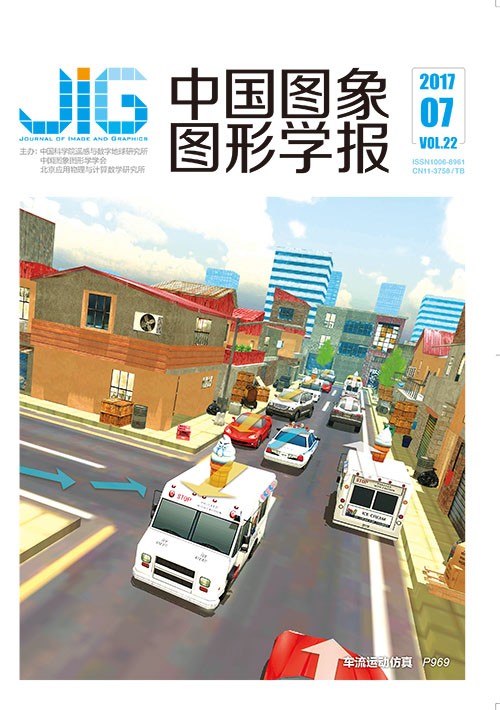
结合四元数与最小核值相似区的边缘检测
摘 要
目的 针对传统彩色图像边缘检测方法中未充分利用图像色度信息、颜色模型间非线性转换过程中时间和空间的大量耗费、算法实现复杂等问题,将四元数引入最小核值相似区(SUSAN)算法中,提出一种RGB空间下的结合四元数与最小核值相似区的边缘检测算法。方法 该算法首先对彩色图像进行四元数描述,然后用改进的SUSAN算子进行边缘检测。针对其中单一几何阈值g的限制,以及检测出的边缘较粗等问题,本文采用Otsu算法自适应获取双几何阈值,再对弱边缘点集进行边缘生长,最后根据USAN重心及其对称最长轴来确定边缘局部方向,实现对边缘点的局部非极大值抑制,得到最终细化后的边缘图像。结果 实验选取1幅合成彩色图像及3幅标准图像库图像,与彩色Canny算法、SUSAN算法,及采用单阈值的本文算法进行对比,并采用Pratt品质因数衡量边缘定位精度。本文算法能够检测出亮度相近的不同颜色区域之间的边缘,且提取的边缘比较连续、细致,漏检边缘较少。与公认边缘检测效果较好的彩色Canny算法相比,本文算法的品质因数提高了0.012 0,耗时缩短了2.527 9 s。结论 本文提出了一种结合四元数与最小核值相似区的边缘检测算法,实现了四元数与SUSAN算子的有效融合。实验结果表明,该算法能够提高边缘定位精度,对弱噪声具有较好的抑制能力,适用于对实时性要求不高的低层次彩色图像处理。
关键词
The edge detection algorithm combining smallest univalue segment assimilating nucleus and quaternion
Li Shanshan1, Chen Li1, Zhang Yongxin1,2, Yin Huarong1, Yuan Yating1(1.School of Information and Technology, Northwest University, Xi'an 710127, China;2.Central Plains Economic Zone wisdom Tourism Cooperative Innovation Center in Henan Province, Luoyang Normal University, Luoyang 471934, China) Abstract
Objective Edge detection is one of the most fundamental operations in image processing and scene analysis systems because edges form the outline of an object. Edge detection is the procedure of detecting meaningful discontinuities of the image function and providing an effective means for image segmentation, image fusion, and pattern recognition. Gray image edge detection has been developed with relative saturation; however, the color image edge detection has not received the same attention. Up to now, most of the existing color image edge detection algorithms are monochromatic-based methods, which produce a superior effect than traditional gray-value methods. Both methods do not completely utilize the chromatic information. Meanwhile, vector-valued techniques treat the color information as color vectors in a vector space provided with a vector norm, thus solving such a problem. However, the vector-valued methods have high complexity and large computation. A color image with three components can be represented in quaternion form as pure quaternions, which can well preserve the vector features of the image pixels. Consequently, the edge detection algorithm combining the smallest univalue segment assimilating nucleus and quaternion in RGB space was proposed to deal with several problems in the traditional color image edge detection methods, such as the insufficient use of chromatic information in color images, the large amount of time and space consumption in the process of nonlinear transformation between color models, and the complex algorithm implementation. Method For a preferable color image edge detection result, we consider the algebraic operation and spatial characteristics regarding the quaternion, as well as the simple and effective edge detection performance of the SUSAN algorithm in our method. The steps of this approach can be summarized as follows. First, the color images are represented with pure quaternions and normalize each pixel. Second, edge detection is performed using the SUSAN operator, which generates a thick edge because of the constraint of the fixed geometry threshold g; hence, the Otsu algorithm is applied to adaptively capture the double geometry thresholds. Third, we make the edge growth on the weak edge set and determine the local edge direction according to the center of gravity and the longest axis of symmetry of SUSAN. Finally, we perform the local non-maximum suppression operation to obtain the final thinned edge image. Result Three classic color images and a synthetic color image with four blocks for specific colors are selected to make a comparison with other edge detection algorithms, including the color Canny algorithm, the SUSAN algorithm, and our method with a fixed threshold to demonstrate the effectiveness and robustness of our method. Two different forms of the geometric threshold are established in our method is to verify whether the selection of the threshold is influential to the final effect of the edge image. We used the Pratt quality factor to conduct a quantitative evaluation of edge positioning accuracy. Experiment results show that our method with less lost edges can detect the edges of different color regions with similar brightness, and the extracted edges are continuous and meticulous. In addition, for the color images with weak noise, our method is very robust that it still can effectively detect the real edge points. Compared with the color Canny algorithm which has the preferable effect of edge detection in color images, the quality factor of our method improved by 0.012 0, and the operation time was reduced by 2.527 9 s. Conclusion In this thesis, we proposed an edge detection algorithm combining the smallest univalue segment assimilating nucleus and quaternion, realizing the effective fusion of quaternion and the SUSAN operator. Setting several different comparative experiments, subjective and objective evaluations show that our method effectively suppressed the weak noise and improved the accuracy of edge localization, which is really suitable for low-level color image processing with low demand in real-time.
Keywords
edge detection of color image quaternion SUSAN operator Otsu algorithm local non-maximum suppression
|



 中国图象图形学报 │ 京ICP备05080539号-4 │ 本系统由
中国图象图形学报 │ 京ICP备05080539号-4 │ 本系统由